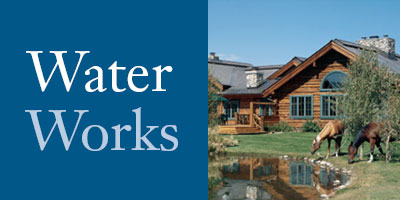Since you're building a home nestled into rural setting, nothing beats a view that includes plenty of trees, a stream or a nearby pond. You probably have the trees, but what if your land isn't blessed with water? Bring the water to you. With the right piece of land and the help of a qualified professional (you can find one at
www.aquascapedesigns.com), building a 1-acre pond is well within your reach. Here's how to build, stock and maintain this wonderful water feature for years of enjoyment.
Step 1: Choose the Type of Pond You Want
After checking the suitability of your site with a professional, you'll need to decide which type of pond is right for the lay of your land. Your choices are an excavated pond, embankment pond or a combination pond, which is a combination of the two.
Step 2: Dig a Hole
If the embankment pond doesn't work for your land, there's no getting around calling out the bulldozers to excavate. A few considerations: For hole size, the rule of thumb is a slope that drops 1 foot in depth for every 3 feet you move toward the center of the pond. A kidney shape maximizes the amount of shoreline.
Step 3: Dam It Up
With embankment and combination ponds, you'll need to construct a dam. Rely on a professional to ensure that the pond remains relatively level during both periods of heavy rain and drought. And like the bottom of the pond, the dam should be constructed of soil that doesn't allow water to seep through.
Step 4: Install a Spillway
This is a pipe (or series of pipes) located at the water level that pass through the dam allowing water to flow and maintaining a consistent water level in the pond.
Step 5: Stabilize The Banks
Seed wild grasses on the dam side of the pond and cover the banks on all sides with clean gravel and rocks to prevent the water from eroding the banks of your newly built pond.
Step 6: Stock Your Pond
For most 1-acre ponds, the right recipe for a fishing hole is 100 "fingerling" (1- to 3-inch fish) large-mouth bass and 500 fingerling bluegill. This should become a self-sustaining population that yield good fishing in about three years.
Step 7: Add a Habitat
Attract large numbers of fish with habitats made from brush piles, stacks of concrete blocks or wooden pallets placed in water about 2 to 8 feet deep and within reasonable casting distance from the shore.
Step 8: Keep Out The Crud
The typical methods for removing algae and other crud are mechanical (literally scooping out the unwanted plants), biological (introducing grass carp to the pond) and chemical (applying herbicides to the surface of the pond).
Step 9: Remove Winter Snow Snow on top of the ice is a problem because it prevents the sun from reaching plants, which in turn prevents the fish from feeding. So take a snowblower to it.
Step 10: Add An Aerator
In the summer, hot temperatures can sap oxygen from the bottom of your pond, which grow until the fish will be gasping for air. So purchase a commercial aerator for your pond. Read the full story in the 2006 April issue of Log Home Living. Photo by Cindy Thiede












